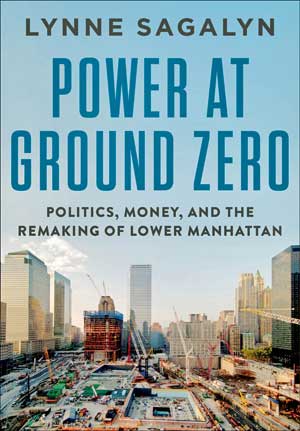
Power at Ground Zero tells the epic story of how the site of the World Trade Center in Lower Manhattan was rebuilt after the terrorist attack of 9/11. The destruction of this complex set in motion a chain of events that fundamentally transformed both the U.S. and the wider world. The attack’s historic trauma endowed these sixteen acres with deep symbolic and emotional meaning that shaped the process and politics of rebuilding. While modern city-building is often dismissed as cold-hearted and detached from meaning, the opposite was true at Ground Zero.
September 11 transformed the human meaning of the Trade Center site. What had been secular was now sacred, a graveyard for nearly three thousand souls. That meant commercial redevelopment replacing 10 million square feet of commercial space would have to “co-exist harmoniously with the memorial itself.” Simply replicating past approaches to city building would constitute a pallid response to human loss and physical destruction of such magnitude. The rebuilding response demanded a big, inspiring, physical presence that embodied the symbolic aspirations of American values and accommodated the twin mandates—to remember and rebuild.
If those twin mandates were clear in the minds of public officials, how to achieve them was not. The lack of a playbook for this unprecedented planning situation created repeated controversies and conflicts. The process was terribly messy and, at times, terribly chaotic. Yet, contrary to the narrative of delay that prevailed throughout the many years of controversy—and that delay was destructive to the revitalization of Lower Manhattan—rebuilding most of the site in fifteen years was relatively fast paced by New York benchmarks for large-scale complex projects.
The money question—who would pay what to rebuild Ground Zero—eluded public consciousness for years. Even elected officials skimmed over this critical driver. By the time it became the obvious driving force after five years of high-profile architectural battles, an exhausted and frustrated public had turned its attention to more immediate stories. The political narrative was dead declared the Times’ Frank Rich in a deeply penetrating op-ed, “Ground Zero Is So Over.” In truth, it was just beginning. The backroom negotiations and the financial deals that would deliver a new World Trade Center were just heating up. This is the story of big money and powerful politicians I tell in Power at Ground Zero. The characters are colorful. The Manhattan real estate is historic. The battles were bellicose. And multiple legacies were lying in wait to be written.
I have long believed that city building is a story of implementation for which plans are but the foundation for debate and action, and that action is driven by politics, big and small. In writing this book, I aimed to tell the full story and to explain why things happened as they did. I wanted readers to understand how the forces of ambition and money and ego shaped the varied strands of this epic story.
Rebuilding Ground Zero presented many tough questions: How would the need to commemorate the loss of thousands of lives be accommodated with the need to rebuild an economic future for Lower Manhattan? How would the rhetoric of defiance and resilience translate into concrete plans, architectural reality, political decisions, building priorities, and economic costs? And who had the power to execute the ideals and ambitions of rebuilding when property rights were split and political power fragmented? And where would the money come from to execute the grand ambitions of rebuilding Ground Zero?
I sought to explain how big money and powerful public officials shape public-interest projects. Important as the planning and architectural phases of the rebuilding process were for cauterizing the immediate trauma of 9/11 by engaging the public with forward-looking visions, the critical decisions—program adjustments, cost compromises, and financial deals—were happening behind the scenes, in the off-the-record negotiations between the Port Authority of New York and New Jersey, as landowner, and real estate developer Larry Silverstein and his investment partnership, as owners of a 99-year lease on the Trade Center consummated just six weeks prior to 9/11.
Those behind-the-scenes actions revealed a truism of public real estate development: one cannot build large without politics. At Ground Zero, politics intersected with economics in powerfully symbolic ways that reveal how cities in the United States get rebuilt.
The book’s chapters take the reader from the tangled start and challenges to the plans for rebuilding through problems of execution to construction completion and opening ceremonies. In each chapter, I unravel the political and economic dynamics that shaped the process of rebuilding, including the billions in public money to ensure visible construction progress by the 10-year anniversary. Most importantly, I explain who had the power to execute the ideals and ambitions of rebuilding. In so doing, the story reveals how high-profile development projects get done in a post-Robert Moses world where political power is fragmented.
Chapter 10 relates a particularly compelling episode of how the idea of integrating culture at Ground Zero exposed the tension inherent in accommodating the dual mandate to remember and rebuild.
Many months of public dialogue on rebuilding and editorial commentary affirmed the cultural objective, and the final master plan allocated five hundred thousand square feet of space across two proposed buildings: a Performing Arts Center and a Memorial Museum and Cultural Complex.
Bringing arts and culture to Ground Zero as part of the rebuilding agenda to help infuse the redevelopment with energy and life appeared to be an idea on which a consensus would readily emerge. But nothing was that clear-cut at Ground Zero. As soon as some of the families of the victims most actively engaged in the memorialization process saw the prosed design of the Cultural Center, the cultural program came under attack and erupted into a fierce political controversy.
Culture threatened to take away “their property.” The arts spaces were competition—for public attention, donations, size and pride of place at Ground Zero. And so these families sought to disrupt the planned selection of cultural groups and successfully petitioned to reduce the scale of the cultural buildings; in turn, the 9/11 Memorial Museum grew in size.
Once the issue of culture became politicized, getting the cultural program back on track became impossible. Orphaned by the episode, culture at Ground Zero still remains a hoped-for element.
The high-profile controversy over culture and the politics of the activist families had a lasting impact on rebuilding. It elevated the political symbolism of the rebuilding effort. As long as decisions were being made about the memorial complex, no politician could take a stand against the emotional claims of the victims’ families.
The families were a political constituency with singular standing whenever they put forth deeply felt desires for specific plans for Ground Zero. However, once most issues relating to remembrance were settled, the focus shifted to commercial arrangements, and the power of the activist families dissipated.
Nevertheless, the reverberations were many. The cultural conflict and its aggressive press coverage infected the public tenor of the entire rebuilding project. It handicapped fundraising for the Memorial, which needed at least $350 million in private contributions. When Governor George E. Pataki stepped into the conflict and banished one of the designated cultural institutions from the Trade Center site, he marginalized his own institutional creation, the Lower Manhattan Development Corporation, set up to do the planning for rebuilding. And given New York City’s civic reputation, the episode stands as an affront to its tradition of tolerance.
The decision-making arena at Ground Zero was filled with many contending voices: elected officials, government decision makers, private real estate interests, the families of 9/11 victims, civic leaders, preservationists, and the editorial boards of the city’s daily newspapers. There was no powerful rebuilding czar, a modern-day Robert Moses, who could overcome the conflict’s imperatives and incessant pressures to “get things done.” The idea of a master builder was out of fashion.
The fragmented ownership of Ground Zero raised thorny issues of control. Yet, most noteworthy, there was no overriding governance structure to set priorities among competing building goals, clarify the inevitable trade-offs, and resolve the inevitable disputes in this most sensitive of public-private projects. And that repeatedly gave rise to the question, “Who’s in control?”
Any force of leadership had to fight against the politics of the complicated structure and its central stakeholders—the Port Authority, the Silverstein Investor Partnership, the 9/11 families, the State of New York, and the City of New York—all of whom by dint of their position became adversaries as they pushed their individual ambitions for rebuilding Ground Zero.
When government entities are not united, as was the case at Ground Zero, developers are able to exploit the fissures among government agencies to their advantage. This is what Silverstein was able to do in 2009-2010 when he did not have sufficient funds to fulfill his rebuilding obligations and tapped public treasuries.
Rebuilding Ground Zero lacked a protocol. It was being figured out on the fly, and that proved to be not just imperfect, but inadequate. It was the structural flaw in the elaborate rebuilding effort. Public-private real estate ventures need to incorporate a protocol for the contingency of catastrophe, for determining who will be in charge and how major decisions will be made, including exiting the partnership. They need more than ideals, more than plans, and more than deals. That is one of the lasting lessons of the landscape of power at Ground Zero.
To a considerable degree, the experience at Ground Zero presents elected officials and policymakers with a question they are likely to confront in future urban situations: What kind of governance structure is best suited for resolving conflicts across fragmented property rights and fragmented government power? Protocols are essential to fair and effective policy governance in situations of extreme civic distress, especially those that execute rebuilding through a formal public-private arrangement. Without a governance protocol, the ability to set priorities is absent. Strong positive leadership matched to a clear protocol for decision-making would have gone a long way to ironing out much angst and confusion, especially in a political context as fragmented as that at Ground Zero.


Lynne B. Sagalyn is the Earle W. Kazis and Benjamin Schore Professor Emerita of Real Estate at Columbia Business School. An expert in urban development and finance, Sagalyn is widely known for her research on public/private partnerships and city building. In addition to Power at Ground Zero: Politics, Money, and the Remaking of Lower Manhattan (Oxford University Press, 2016), regarded as the definitive account of the rebuilding challenge and featured in her Rorotoko interview, she is the author of Times Square Roulette: Remaking the City Icon (MIT Press, 2001) and co-author of Downtown, Inc.: How America Rebuilds Cities (MIT Press, 1989). Professor Sagalyn serves as a director of several real estate companies and nonprofit organizations in New York City. Born in Queens, Professor Sagalyn now lives on the Upper West Side with her husband.